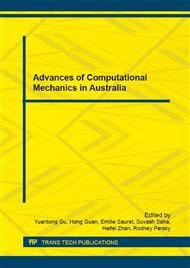p.270
p.276
p.282
p.288
p.294
p.300
p.306
p.312
p.318
Simulating the Contact of Golf Club to Ball for Improved Performance
Abstract:
Long before FEA was developed, people were participating in sports and as competition intensified is became clear that for many sports, the equipment plays as important a part in performance as does the athlete. With the use of modern materials and manufacturing processes there is always scope for maximizing the performance of sporting equipment. Traditionally improvements were incremental, as athletes fed-back suggestions to manufacturers and new prototypes were built and tested. Given the cost of tooling for many of the current manufacturing methods, carbon fibre with resin infusion to mention one, it is clear that such build and test iterations are not as preferable given the potential of limited success and high cost.Modern simulation techniques are capable of examining a “day–in–the-life” of an object and from an examination of the envelope of response the most sensitive regions can be detected. Iteration on the design variables, provided they remain within any constraints, be they physical or otherwise, can be incorporated to investigate their effect on performance.In this paper non-linear transient dynamic (NLTD) FEA is undertaken on a 3 iron golf club impacting a golf ball. During the less than 0.5 millisecond impact the whole outcome of the shit is established. Design changes that can lead to improved performance are studied. From the FEA simulation information on ball top spin, side spin, take off velocity are investigated.
Info:
Periodical:
Pages:
294-299
Citation:
Online since:
July 2016
Authors:
Price:
Сopyright:
© 2016 Trans Tech Publications Ltd. All Rights Reserved
Share:
Citation:


